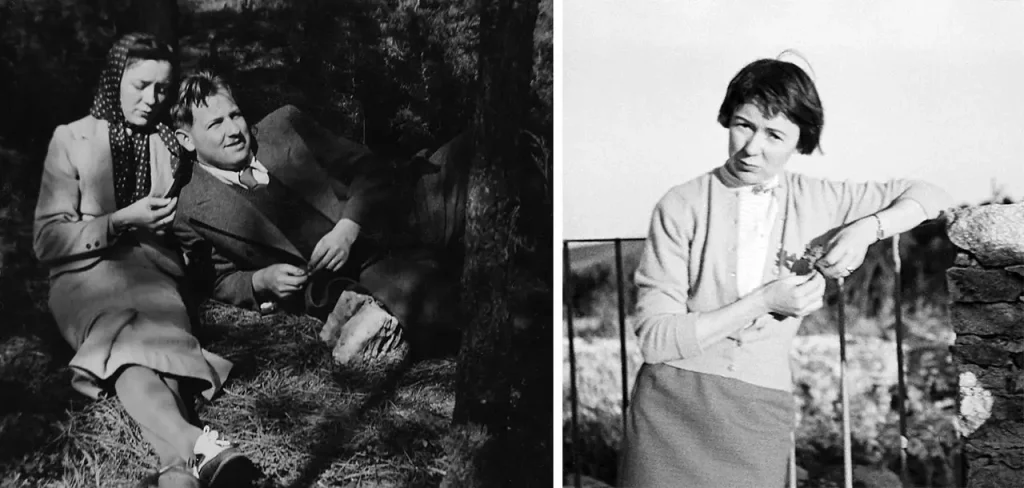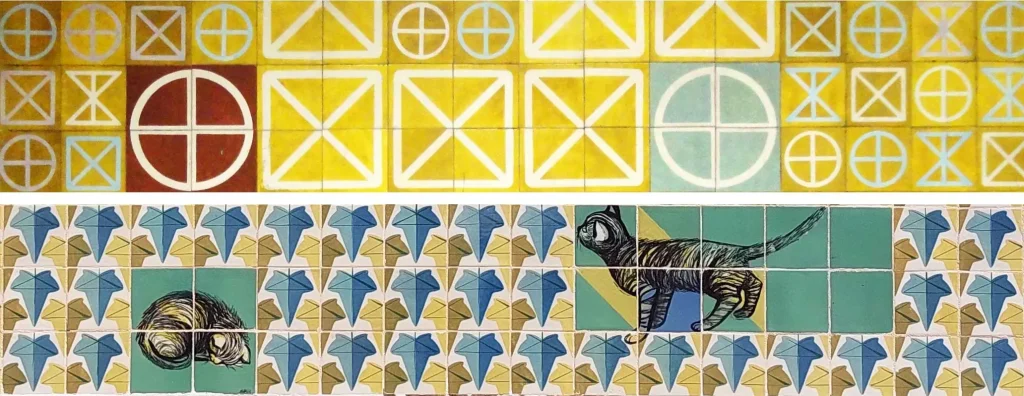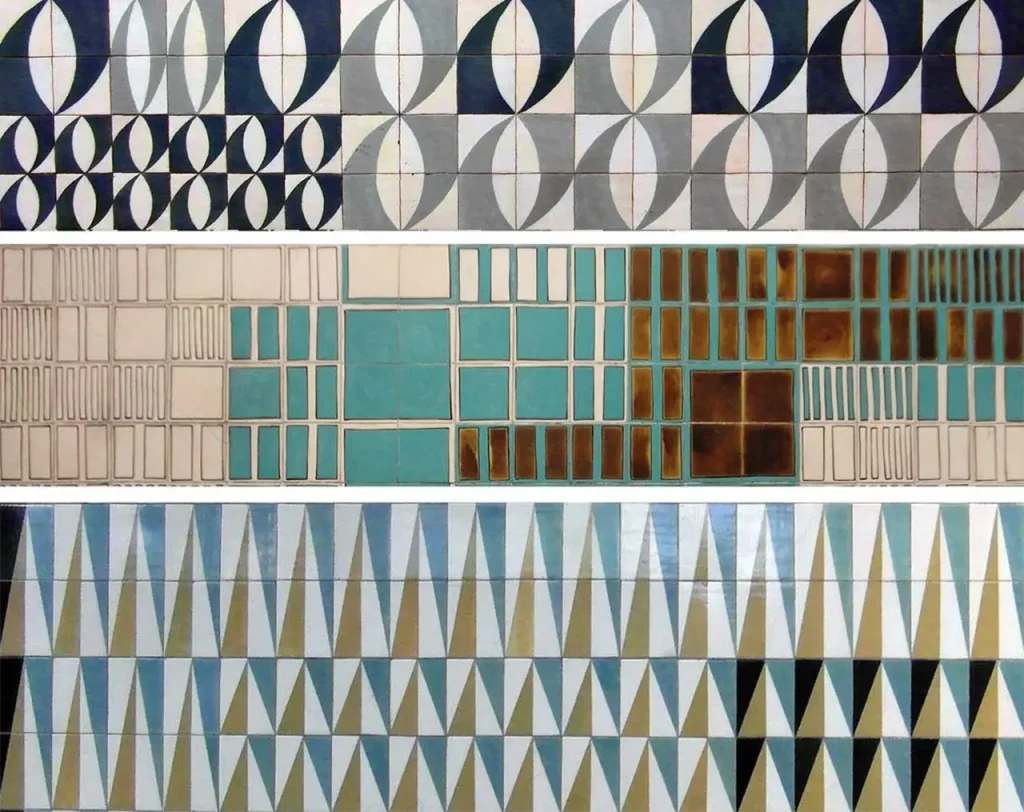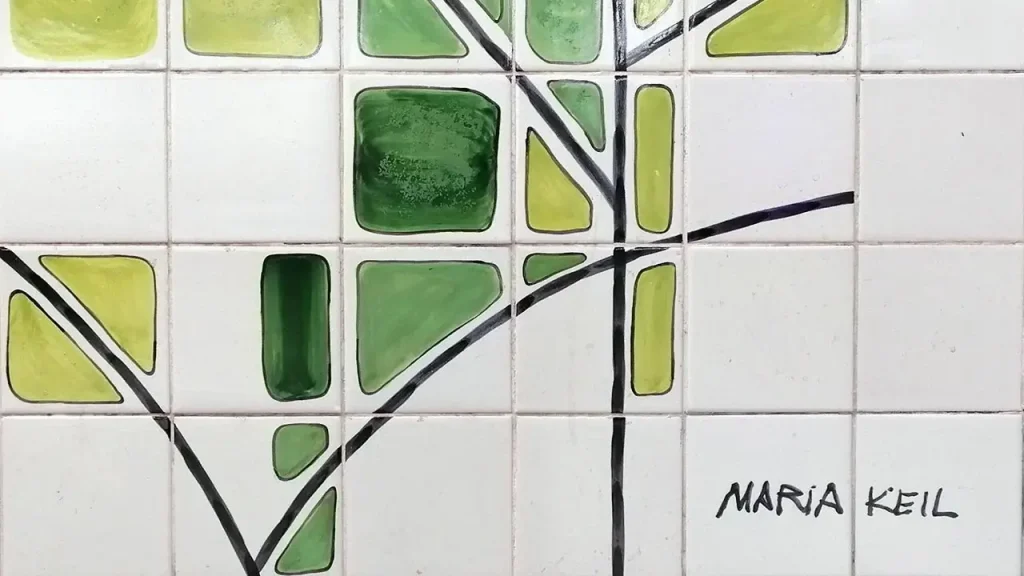Today we’re talking about Maria Keil, a pioneer artist of the Lisbon Metro, who revolutionised modern Portuguese tilework with her creative interventions.
Maria Keil was born in Silves in August 1914 and was one of the most significant figures in Portuguese art in the 20th century, producing an extensive and diverse body of work from the 1930s until her passing in 2012.
Identified by the historian José Augusto França as part of the second generation of Portuguese modernists, Maria Keil initially distinguished herself in graphic arts, advertising, and decorative arts. Later, she became especially renowned as an illustrator, particularly of children’s books, and for her unique and acclaimed tilework. The latter is considered her most significant contribution, both for revitalising tile use during a period of decline and for establishing a legacy of tile art of remarkable importance.
Maria Keil’s Life and Work, A Brief Overview
Born Maria da Silva Pires, she became Keil do Amaral in 1933 following her marriage to the renowned architect, who introduced her to the social circles of avant-garde artists and intellectuals. This exposure encouraged her departure from academicism in favour of modernist art.

In the 1930s and 1940s, she worked in graphic arts, advertising, costume design, and set design, collaborating with prominent figures like Ofélia Marques and Fred Kradolfer. During this time, she decorated spaces for international exhibitions and various projects promoted by the authoritarian regime, including the 1940 Exposição do Mundo Português, which sought to project an image of modernity and progress that was simultaneously traditional and nationalistic.
After World War II, as repression intensified in response to increased dissent, Portugal’s dictatorship paralleled that of neighbouring Spain, where both sought to maintain power despite the fall of fascist allies.
Although Maria Keil continued working under the Estado Novo regime, both she and her husband were opponents of Salazar’s government. They were active in the MUD (Democratic Unity Movement), and in 1953 Maria Keil was briefly imprisoned by PIDE, the state’s political police, for supporting journalist and feminist activist Maria Lamas.
Her political stance influenced the next stage of her career, in which most of her work was commissioned by private clients and institutions.


Maria Keil and Modern Tile Art
Maria Keil considered tile art to be her most significant field, aware of her contributions to this medium that had centuries of tradition in Portugal.
After reaching a decorative peak in the 18th century, the practical value of tiles became evident, initially as a way to facilitate maintenance of interior spaces. Later, under Brazilian influence, on building façades, to add a unique brightness to the colour and light of cities like Lisbon.
Façade tiles were industrial pieces produced using stencil or transfer printing techniques, with repeating modules that created patterns, sometimes framed by friezes surrounding the openings, enhancing and valuing the rhythms imposed by the architecture.

These interventions were primarily implemented by property owners who sought to facilitate the maintenance of their buildings, as well as to create a distinctive element from their neighbours. However, this was not a common practice among architects, who, at the turn of the 19th to the 20th century, opted for friezes, frames, or the filling of small decorative areas, as exemplified by many works created by the painter J. Pinto for projects by the architect Ventura Terra.

In the 1930s, new modernist architectural concepts favoured rectangular volumes with simple, straight lines, a rationalist geometrisation that dismissed decorative and ornamental elements in favour of functionality.
Only in the 1950s, again influenced by Brazilian productions, particularly those of Portinari and Niemeyer, did national architects return to collaborating with visual artists, ceramicists, and sculptors to collectively enhance the aesthetic quality of their projects. In this way, they contributed to the modernisation and rehabilitation of tile as an exceptional cladding material in the national landscape.
It is in this context that Maria Keil was invited to contribute with her creativity to address the cladding of large openings, a task that would prove to be much more demanding than it initially appeared.
Engaged in continuous dialogue with architectural structures, Maria Keil developed abstract geometric patterns that varied in size, colour, and proportion, creating effects of depth, rhythm, and movement.
These patterns often served as a backdrop to stylised, graphic motifs that blended seamlessly with one another.

| Never miss another article | Subscribe here |
The Tiles of the Lisbon Metro
In the mid-1950s, Maria Keil embarked on her most ambitious project — the Lisbon Metro.
The construction of this revolutionary mode of transport began in 1955 and was completed four years later. Eleven stations were initially opened, followed by eight more during the second phase of construction, which took place between 1963 and 1973.
The project by architect Francisco Keil do Amaral consisted of functional vaulted corridors connecting the access points to the atriums and the staircases to the stations. However, it was necessary to enliven, illuminate, and individualise the stations. Despite the lack of funds from the Metro for these finishes, the architect turned to his wife’s creativity and together they developed a cost-effective and highly efficient proposal: the tile cladding. This solution would introduce colour and brightness, distinguishing and characterising each station.
Thus, while the corridors featured wainscoting covered with mosaic tiles (small pieces of coloured glass paste that were very in vogue at the time), the atriums and the staircases leading to the stations were adorned with the works that Maria Keil would design and create in collaboration with the struggling Viúva Lamego Factory, a highly successful partnership that would extend beyond the Metro projects.
Only the Avenida station was entrusted to Rogério Ribeiro, while all the others were designed by Maria Keil.
In addition to the challenge of designing panels several metres long, a rule was imposed directly from Salazar’s office that prohibited the use of figurative elements. It was believed that these elements could cause accidents by distracting users’ attention, but perhaps the true reason was related to the artist’s expression and the themes touching on neo-realism, an aesthetic that was not suitable for the regime.
Thus, by using abstract geometric modules that transformed and created unexpected rhythms and dynamics, Maria Keil not only fulfilled the initial objective but also made her work timeless.

If we pay attention to some of these projects, we will find elements that refer to motifs present in ancient tilework, such as geometric patterns from Moorish alicatado tiles, diamond tip tiles, the armillary sphere and acanthus leaves…

At the Restauradores station, it was possible to make an exception to this rule and introduce traditional albarradas (decorative tile bands featuring floral or geometric motifs) with blue and white flowers among the abstract modules. Unfortunately, these tiles were destroyed during the station’s expansion in 1977, as were others in different stations.
In 2009, the São Sebastião station became a connection hub between two lines and was completely remodelled, featuring contributions from various artists, including once again the pioneering Maria Keil. Her mural, designed a decade earlier, presents a stylised representation of trees evoking the surrounding green spaces. A closer look reveals birds nestled among the branches, a figurative element that can be interpreted as a symbol of freedom.
This was her final contribution to the Lisbon Metro, but her earlier works remain present, fully or partially, in stations like Rossio, Marquês de Pombal, Parque, Alvalade, Roma, Arroios, and Anjos…
An imagery that accompanies us daily on our journeys, but yet often goes unnoticed by so many!
The project getLISBON has been very rewarding and we want to continue revealing the singularities of fascinating Lisbon.
Help us keep this project alive!
By using these links to make your reservations you’ll be supporting us. With no extra costs!
• Looking for a different experience? We can create a customised itinerary based on your interests. Contact us!
• Or if you prefer tours and other activities in various destinations, take a look at GetYourGuide.
• Save time and money with a flexible Lisbon Card!




